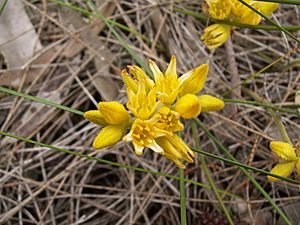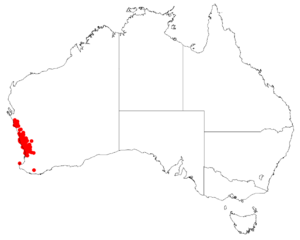Golden conostylis facts for kids
Quick facts for kids Golden conostylis |
|
|---|---|
 |
|
| C. aurea near Jurien Bay, Western Australia | |
| Scientific classification | |
| Genus: |
Conostylis
|
| Species: |
aurea
|
 |
|
| Occurrence data from AVH | |
| Synonyms | |
|
|
The Golden Conostylis (scientific name: Conostylis aurea) is a beautiful plant found in the bloodwort family, called Haemodoraceae. This plant is special because it only grows in the south-west part of Western Australia. When a plant or animal only lives in one specific area, it is called endemic.
Contents
What the Golden Conostylis Looks Like
The Golden Conostylis is a type of plant that grows from underground stems, which are called rhizomes. This helps it spread and form new plants. It grows in clumps, much like grass, and is a perennial plant, meaning it lives for many years.
This herb can grow to be about 0.15 to 0.4 meters (0.5 to 1.3 feet) tall. It can also spread out to about 0.3 meters (1 foot) wide. Its leaves are long and thin, shaped like straps.
The flowers of the Golden Conostylis grow in groups on stalks that come up from the bottom of the plant. Each flower has six parts that look like petals, called tepals. It also has six stamens, which are the parts of the flower that produce pollen.
A botanist named John Lindley, who first described this plant, thought it was very pretty. He wrote that its flowers are a "bright golden yellow," which is how it got its common name.
How the Golden Conostylis Got Its Name
The Golden Conostylis was first officially described in 1840. This was done by a botanist named John Lindley. He wrote about it in his book, A Sketch of the Vegetation of the Swan River Colony.
The second part of its scientific name, aurea, comes from the Latin word aurum. This word means "gold," which perfectly describes the plant's bright yellow flowers.
Where the Golden Conostylis Grows
You can find the Golden Conostylis in several different natural areas of Western Australia. These areas include the Avon Wheatbelt, Esperance Plains, Geraldton Sandplains, Jarrah Forest, and Swan Coastal Plain.
This plant likes to grow in sandy or gravelly soil. It often prefers places that get wet during the winter months.
Protecting the Golden Conostylis
The Golden Conostylis is currently considered a safe plant. The Western Australian Government's Department of Parks and Wildlife has classified it as "not threatened." This means it is not in danger of disappearing.

